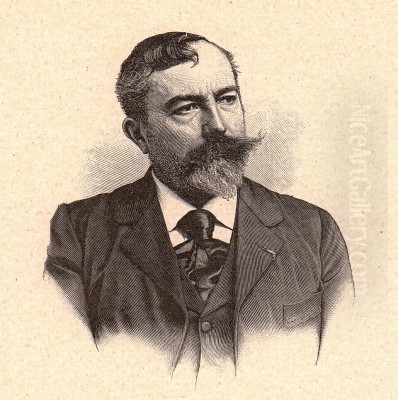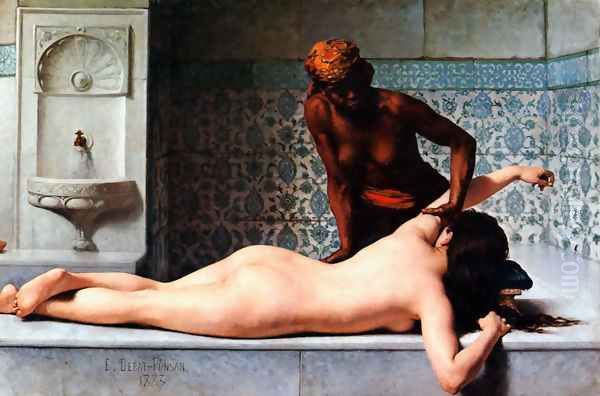
Edouard Bernard Debat-Ponsan stands as a significant, if sometimes overlooked, figure in late 19th and early 20th-century French art. Born in Toulouse on April 25, 1847, and passing away in Paris on January 29, 1913, his career spanned a period of immense artistic upheaval and societal change. Trained in the rigorous academic tradition, Debat-Ponsan became known for his versatility, tackling historical scenes, rustic genre paintings, Orientalist subjects, and portraits with considerable skill. His staunch Republican views and engagement with contemporary political events, most notably the Dreyfus Affair, also marked his life and career, setting him apart from many of his contemporaries.
Early Life and Academic Foundations
Debat-Ponsan's artistic journey began in his native Toulouse, but like many aspiring artists of his generation, he soon gravitated to Paris, the epicenter of the art world. There, he enrolled in the prestigious École des Beaux-Arts, the bastion of academic art in France. His tutelage under Alexandre Cabanel, one of the most successful and influential academic painters of the Second Empire and early Third Republic, was formative. Cabanel, known for works like The Birth of Venus, instilled in Debat-Ponsan a respect for classical composition, meticulous draughtsmanship, and the grand tradition of history painting.
During his time at the École, Debat-Ponsan would have been surrounded by a generation of artists who were both upholding and challenging academic norms. He competed for the coveted Prix de Rome, a scholarship that allowed winners to study in Italy. In 1873, he achieved a second Grand Prix de Rome for his painting, a significant honor that signaled his promise. He also won the Prix Troyon in 1874, further establishing his reputation within academic circles. His peers at this time might have included artists like Jean-Joseph Benjamin-Constant, also a student of Cabanel and later known for his Orientalist and historical scenes, or Jules Bastien-Lépage, who, while academically trained, moved towards a more naturalistic portrayal of rural life.
A Versatile Painter: Themes and Styles
Debat-Ponsan's oeuvre is characterized by its thematic diversity, reflecting both the academic expectations of his time and his personal interests. He was adept at navigating various genres, consistently demonstrating technical proficiency and a keen observational eye.
Historical and Genre Painting

In line with his academic training, Debat-Ponsan produced a number of significant history paintings. These works often depicted dramatic moments from French history or classical antiquity, executed with the narrative clarity and compositional grandeur favored by the Salon. One notable example is Un matin devant la porte du Louvre (A Morning Before the Louvre Gate, 1880), which captures a historical scene with attention to period detail and human drama. Such paintings were intended for public exhibition and aimed to edify and impress the viewer, reinforcing cultural and national narratives.
Beyond grand historical narratives, Debat-Ponsan was also drawn to genre scenes, particularly those depicting French peasant life. These works, often characterized by a rustic realism, resonated with a contemporary interest in rural traditions and the dignity of labor. Paintings like Les vaches à l’abreuvement (Cows at the Watering Place) showcase his ability to capture the pastoral atmosphere and the connection between humans, animals, and the land. This focus on rural themes connected him to a broader tradition in French art, exemplified by artists like Jean-François Millet, though Debat-Ponsan's approach remained more aligned with academic aesthetics than Millet's profound social realism. His painting A Corner of the Vineyard also exemplifies this interest in the French countryside.
The Allure of Orientalism
Like many 19th-century European artists, Debat-Ponsan was captivated by the "Orient"—a term then used to describe North Africa, the Middle East, and sometimes parts of Asia. This fascination, fueled by colonial expansion, travel accounts, and a romantic desire for the exotic, led to a flourishing of Orientalist art. Debat-Ponsan contributed to this genre with works that often depicted scenes of daily life, sensuous figures, and richly detailed settings.
His painting Le Massage, scène de Hammam (The Massage, Hammam Scene, 1883) is a prime example of his Orientalist work. It portrays a scene within a Turkish bath, a popular subject that allowed artists to explore themes of leisure, sensuality, and the female nude in an exoticized context. While Debat-Ponsan may not have traveled as extensively as dedicated Orientalists like Eugène Fromentin or Jean-Léon Gérôme, his works drew upon the established visual vocabulary of the genre, influenced by earlier masters such as Eugène Delacroix and Jean-Auguste-Dominique Ingres, who had pioneered Orientalist themes in French art. These paintings catered to a European audience intrigued by cultures perceived as vastly different from their own.
Portraiture
Debat-Ponsan was also an accomplished portraitist, commissioned to paint various figures of his time. His portraits were generally characterized by a realistic depiction of the sitter, combined with an understanding of academic conventions that lent dignity and presence to the subject. While perhaps not as innovative as the portraits being produced by Impressionists like Edgar Degas or Berthe Morisot, Debat-Ponsan's work in this genre was solid and respected, fulfilling the expectations of his clientele.
Political Convictions and Artistic Engagement: The Dreyfus Affair
A defining aspect of Debat-Ponsan's life and career was his strong Republican political convictions and his willingness to engage with contemporary social and political issues through his art. This was most evident during the Dreyfus Affair, a political scandal that deeply divided French society from 1894 until its resolution in 1906. Captain Alfred Dreyfus, a Jewish artillery officer in the French army, was falsely convicted of treason. The case exposed rampant anti-Semitism and highlighted the deep fissures within the Third Republic.
Debat-Ponsan was a fervent "Dreyfusard," believing in Dreyfus's innocence and supporting the cause for his exoneration. He aligned himself with prominent intellectuals and artists who championed justice and truth, such as the writer Émile Zola, whose famous 1898 open letter "J’Accuse…!" was a pivotal moment in the Affair. Debat-Ponsan's commitment to the Dreyfusard cause found powerful expression in his allegorical painting La Vérité sortant du puits (Truth Coming Out of the Well), also known as Nec Mergitur, exhibited at the Salon of 1898. The painting depicts a nude female figure representing Truth, emerging from a well, holding a mirror to reflect reality, while shadowy figures attempt to suppress her. It was a bold and direct artistic statement on a highly contentious political issue.
This public stance, however, came at a personal and professional cost. In a society deeply polarized by the Affair, supporting Dreyfus could lead to social ostracism and loss of patronage, particularly from conservative and anti-Dreyfusard circles. Indeed, Debat-Ponsan reportedly lost many clients due to his political views. This willingness to sacrifice professional advancement for his convictions underscores the depth of his Republican ideals. His political engagement set him apart from many academic artists who preferred to remain aloof from such controversies, and also distinguished him from avant-garde artists whose rebellion was primarily aesthetic rather than overtly political in the same manner.
Later Career, Recognition, and Legacy
Despite the challenges posed by his political engagement, Debat-Ponsan continued to work and exhibit. He received official recognition, including being made a Chevalier of the Legion of Honour in 1881, and later an Officer. He also won a bronze medal at the Exposition Universelle (World's Fair) in Paris in 1889. His works were acquired by various French museums, and he undertook decorative commissions, including for the Capitole de Toulouse, his hometown's city hall, where his painting Le Chapeau de Toulouse (The Hat of Toulouse) is noted. Another early work, La Récit de Philétas (The Tale of Philetas, 1870), and his religious painting Saint Paul devant l’Aréopage (Saint Paul Before the Areopagus, 1877), also contributed to his reputation.
In his later years, Debat-Ponsan reportedly withdrew somewhat from the Parisian art scene, spending more time in Nazelles, near Tours, and in his native region. He continued to paint, focusing increasingly on landscapes and scenes of rural life, perhaps finding solace and inspiration away from the political turmoil of the capital.
In the broader narrative of art history, Edouard Debat-Ponsan occupies a complex position. He was undeniably a product of the academic system, mastering its techniques and contributing to its favored genres. However, he was not merely a conformist. His engagement with rustic realism, his exploration of Orientalist themes, and, most significantly, his politically charged art demonstrate a painter who was responsive to the currents of his time.
He worked during a period when the dominance of academic art was being decisively challenged by Impressionism and Post-Impressionism. Artists like Claude Monet, Pierre-Auguste Renoir, Camille Pissarro, and later Paul Cézanne, Vincent van Gogh, and Paul Gauguin, were forging new visual languages that would ultimately redefine modern art. Compared to these revolutionary figures, Debat-Ponsan's style remained largely traditional. Yet, within the academic framework, he carved out a distinctive path. His contemporary, William-Adolphe Bouguereau, represented a more polished and idealized form of academicism, while Ernest Meissonier excelled in meticulously detailed historical and military scenes. Debat-Ponsan's work, with its blend of realism, historical narrative, and political commentary, offers a different facet of this era.
His early, unpublicized work, such as the sketches for his 1876 Prix de Rome entry Priam aux pieds d'Achille (Priam at the Feet of Achilles), which was ultimately lost, hints at the rigorous classical training that underpinned his career. His competition with artists like Fernand Lematte for such prizes was part of the crucible that forged academic painters.
Conclusion: A Man of Art and Conviction
Edouard Debat-Ponsan was more than just a skilled academic painter. He was an artist who navigated the complex artistic and political landscape of late 19th-century France with integrity and conviction. His diverse body of work, from grand historical canvases and evocative Orientalist scenes to intimate rural landscapes and powerful political allegories, reflects a multifaceted talent. While perhaps not as revolutionary as the Impressionists or Post-Impressionists who were his contemporaries, Debat-Ponsan's art provides valuable insight into the mainstream artistic production of his era, and his courageous stance during the Dreyfus Affair marks him as a man of principle. His legacy is that of an artist who successfully combined academic tradition with a keen awareness of the social and political realities of his time, leaving behind a body of work that continues to be appreciated in museums and collections, particularly in France. He remains a testament to an era where art could be both a reflection of established tastes and a potent vehicle for social commentary.